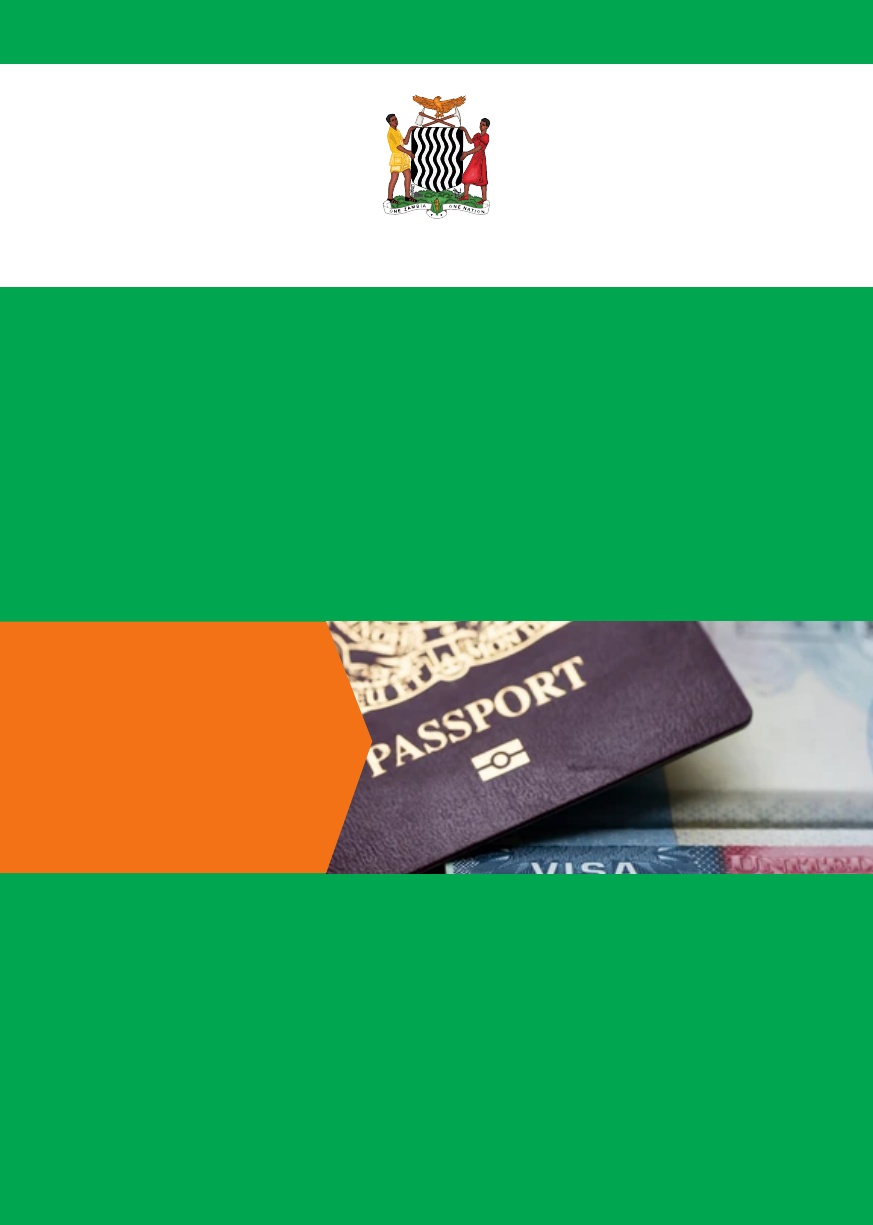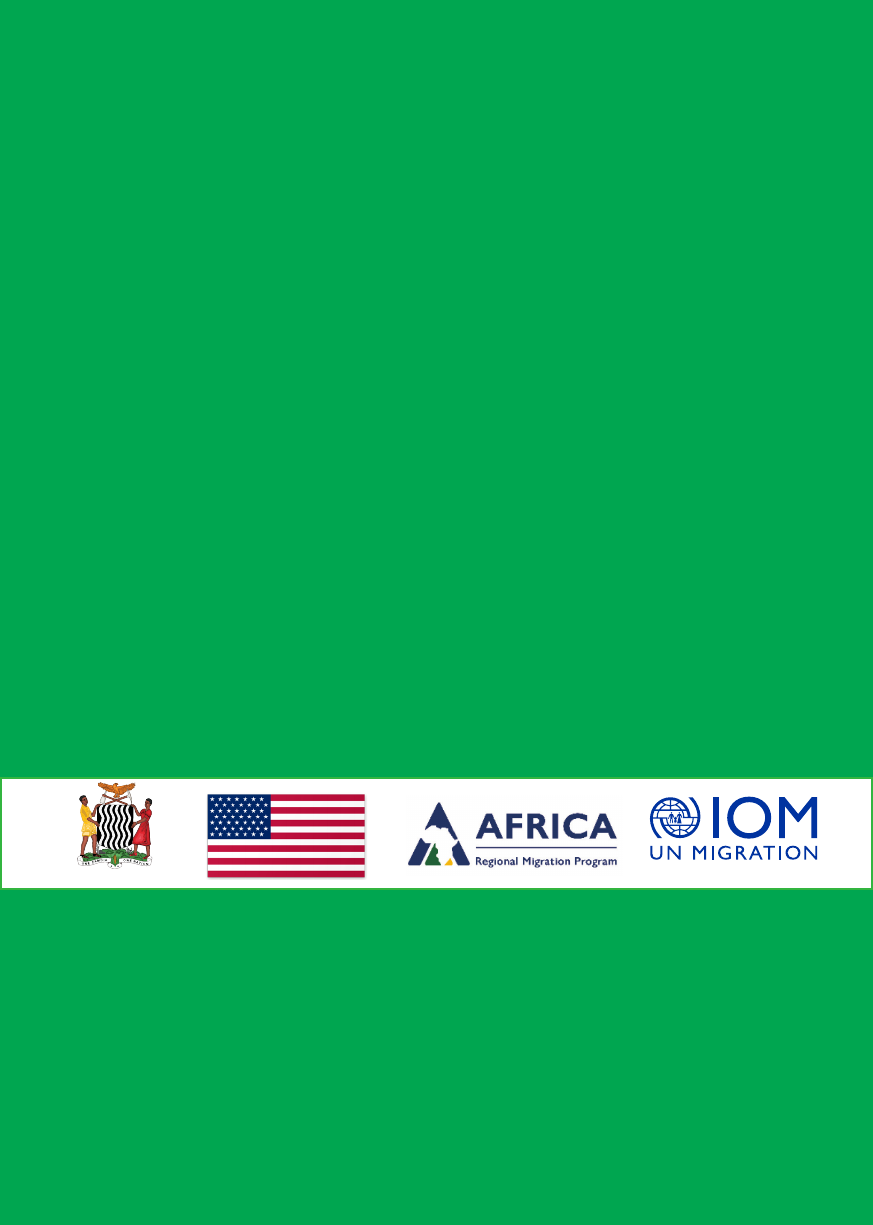
NATIONAL MIGRATION POLICY
July, 2022
Republic of Zambia

National Migration Policy
i
CONTENTS
FOREWORD ................................................................................................................................ii
ACKNOWLEDGEMENT .......................................................................................................... iii
WORKING DEFINITIONS ....................................................................................................... iv
ACRONYMS ..............................................................................................................................vii
1.0 INTRODUCTION ..................................................................................................1
2.0 SITUATION ANALYSIS ........................................................................................ 3
2.1 Migration Governance.........................................................................................4
2.2 Labour Migration and Education ....................................................................4
2.3 Diaspora Engagement ........................................................................................5
2.4 Migration, Trade and Tourism ...........................................................................5
2.5 Border Governance ..............................................................................................6
2.6 Irregular Migration ................................................................................................6
2.7 Forced Displacement ...........................................................................................7
2.8 Internal Migration .................................................................................................7
2.9 Migration and Health ......................................................................................... 8
2.10 Cross Cutting Issues ............................................................................................. 8
3.0 VISION, RATIONALE AND GUIDING PRINCIPLES ......................................10
3.1 Vision ....................................................................................................................... 10
3.2 Rationale ............................................................................................................... 10
3.3 Guiding Principles ............................................................................................... 10
4.0 OBJECTIVES AND MEASURES ........................................................................12
4.1 Objectives ..............................................................................................................12
4.2 Measures ...............................................................................................................12
5.0 IMPLEMENTATION FRAMEWORK ..................................................................15
5.1 Institutional Arrangements..............................................................................15
5.2 Legal Framework ................................................................................................. 18
5.3 Resource Mobilization and Financing ..........................................................19
5.4 Monitoring and Evaluation .............................................................................20

National Migration Policy
ii
FOREWORD
I
n an era of unprecedented human mobility, migration
has become a critical policy area at global, regional
and national levels. It is imperative to leverage the
socio-economic opportunities whilst minimizing the
adverse impact associated with migration. There is
increasing recognition that migration, if well managed,
brings profound benefits to the migrants, countries of
origin, transit and destination.
In view of the foregoing, the Government realizes that
in order to achieve the Agenda 2030 for Sustainable
Development and National Vision 2030 which is
aimed at attaining a prosperous middle-income status, the country needs to
comprehensively include migrants in the development agenda. The development
of the National Migration Policy demonstrates Government`s commitment to well-
managed migration which contributes to improved national security and socio-
economic development.
The challenges related to migration in Zambia include mixed migration flows,
human trafficking, smuggling of persons, long porous borders, irregular migration,
forced displacement, inadequate disaggregated migration data, strain on urban
and social amenities, smuggling of goods, untapped development potential of labor
migration and remittances. The situation has been compounded by the absence of a
coherent and comprehensive migration policy framework. In view of the challenges,
the Government has developed this Policy in order to deliver a well-coordinated
framework that enhances the positive contributions of the migrants to national
development. The National Migration Policy provides the basis for mainstreaming
migration in national development plans, improved comprehensive and coherent
migration management, harnessing the migration – development relationship,
enhancing national security and strengthening the protection of migrants. The
National Migration Policy will also contribute towards poverty alleviation, improved
remittance flows, data collection, analysis, utilization and dissemination.
I am therefore, confident that this National Migration Policy will be used to inform
national strategies, laws and programmes that are responsive to the contributions
and needs of migrants aimed at accelerating socio-economic development. In the
same vein, I call upon all stakeholders to take keen interest in the implementation
of this National Migration Policy through a multi-sectoral approach.
Hon. Jack J. Mwiimbu, MP.
MINISTER OF HOME AFFAIRS AND INTERNAL SECURITY

National Migration Policy
iii
ACKNOWLEDGEMENT
T
his National Migration Policy is a product of
contributions and consultations with various
stakeholders engaged by the Ministry of Home
Affairs and Internal Security. Therefore, commendations
go to all stakeholders who effectively participated in
the formulation of the Policy.
Special gratitude goes to the International Organization
for Migration (IOM) for the technical and financial
support. Further appreciation goes to the National
Technical Committee for their commitment and tireless
effort demonstrated during the consultations, drafting,
refinement and finalization of this Policy.
Dickson Matembo (Mr.)
Permanent Secretary - CRIAR
MINISTRY OF HOME AFFAIRS AND INTERNAL SECURITY

National Migration Policy
iv
WORKING DEFINITIONS
For the purpose of this Policy, the following shall apply:
Asylum Seeker:
A foreign national who is seeking protection and
whose refugee claim has not been determined
Border Governance:
Legislation, policies, and plans related to the entry
and exit of persons, goods and services from the
country
Child:
A person who is 18 years and below
Control Zone:
Part of the territory of an adjoining State or Zambia
within which officers are empowered to effect border
controls
Detention:
Deprivation of liberty or confinement in a closed
place in which a migrant is not permitted to leave at
will, including, though not limited to, correctional
facilities or purpose-built detention, closed referral or
holding centres or facilities
Diaspora:
People who have dispersed or spread from their
original country
Forced migration:
A migratory movement which, although the drivers
can be diverse, involves force, compulsion or cohesion
Formal sector:
All production units that are registered with a tax and
or a licensing authority
Holding facilities:
Centres designated for the temporary retention of
migrants who have committed non-custodial
offences, victims of trafficking and smuggled persons
Human smuggling:
The procurement, in order to obtain, directly or
indirectly a financial or other material benefit of the
irregular entry of a person into a state party of which
a person is not a national or permanent resident
Human trafficking:
The recruitment, transportation, transfer, harbouring
or receipt of persons for the purpose of exploitation
Informal sector:
All production units that are not registered with a tax
or a licensing authority
Internal migration:
Movement of persons across administrative
boundaries within the country

National Migration Policy
v
Internally
Displaced Persons
(IDPs):
Persons or groups of persons who have been forced
or obliged to flee or to leave their homes or places of
habitual residence within Zambia
Irregular Migration:
The movement of persons that takes place without
the necessary authorisation or documents required
under immigration regulations
Migrant Stock:
The number of migrants present in a given country at
a particular point in time
Migrant:
A person who moves away from their usual place of
residence, within a country or across an international
border for a variety of reasons
Migration
Governance:
The traditions and institutions by which authority on
migration, mobility and nationality are exercised
Migration:
The movement of a person or a group of persons,
either across an international border, or within a State
Mixed Migration:
Migratory population movements that may include
refugees, asylum-seekers, economic migrants and
other migrants moving in groups that generally takes
place in an irregular manner using same routes and
means of transport for different reasons
National Referral
Mechanism (NRM):
A mechanism that provides guidance on the
assistance to vulnerable migrants requiring
protection and promotes coordination of national
stakeholders using a human rights-based approach in
line with national legal frameworks and international
best practices
Port of Entry:
A point or area gazetted through which goods and
persons may enter or exit the country
Pull Factors:
Positive aspects that attract people to move to a
place
Push Factors:
Negative aspects that compel people to leave their
usual place of residence
Refugee:
A person who owing to:

National Migration Policy
vi
a) a well-founded fear of being persecuted for
reasons of race, religious beliefs, nationality,
membership of a particular social group or political
opinion is outside the country of nationality and
is unable, or owing to that fear is unwilling, to be
protected by that country;
b) not having a nationality and being outside
the country of that person’s former habitual
residence is;
c) external aggression, occupation, foreign
domination or serious disturbance of public order
in part or the whole of that person’s country of
origin or nationality, is compelled to leave that
person’s place of habitual residence in order
to seek refuge in a place outside that person’s
country of origin or nationality; or
d) internal conflict, generalised violence, massive
violation of human rights or other circumstances
that have seriously disturbed public order in that
person’s country of origin, that person’s life, safety
or freedom has been threatened
i) unable to return to that country; or
ii) unwilling to return to that country due to a
well-founded fear of being persecuted for
reasons of race, religion, membership of a
particular social group or political opinion
Reintegration:
The process of reuniting a person with their community
or country of origin
Remittances:
Money or material resources transferred by migrants
back to their country of origin
Separated
Children:
Children who have been separated from both parents
or from their previous legal or customary care giver but
not necessarily from other relatives
Stateless Person:
A person who is not considered as a national by any
State under the operations of the law
Unaccompanied
Children:
Children who have been separated from both
parents, other relatives and not being cared for by an
adult who by law or custom is responsible for doing so;
and
Youth:
A person who has attained the age of 19 years but is
below the age of 35 years

National Migration Policy
vii
ACRONYMS
7NDP ---------Seventh National Development Plan
AU -------------African Union
AUMPF -------African Union Migration Policy Framework
AVRR ---------Assisted Voluntary Return and Reintegration
COMESA -----Common Market for Eastern and Southern Africa
COVID-19 ----Corona Virus Disease – 2019
CSOs ----------Civil Society Organisations
GCM ----------Global Compact for Safe, Orderly and Regular Migration
GFMD --------Global Forum for Migration and Development
IBM -----------Integrated Border Management
IDP ------------Internally Displaced Person
IMS ------------Information Management System
IOM -----------International Organization for Migration
LMIS ----------Labour Market Information System
MGI -----------Migration Governance Indicators
MIDCOM -----Migration Dialogue for Common Market for Eastern and Southern
Africa
MIDSA --------Migration Dialogue for Southern Africa
PAFOM -------Pan African Forum for Migration
RECs ----------Regional Economic Communities
SADC ---------Southern African Development Community
SARS ----------Severe Acute Respiratory Syndrome
ZQF -----------Zambia Qualification Framework

National Migration Policy
1
1.0 INTRODUCTION
M
igration has become topical at the global, continental and regional
levels due to its scope, scale and complexity. Migration yields significant
benefits for both origin and destination countries. In countries of
destination, the benefits of migration include filling critical skills gaps, improved
productivity, increased output, and cultural diversity. In countries of origin, on
the other hand, migration is beneficial in terms of remittances by migrants,
diaspora investment, knowledge, technology and skills transfer from return
migrants. Migration contributes to economic growth and improves food
security and rural livelihoods. Orderly, safe and regular migration underpins
the achievement of the Agenda 2030 for sustainable development including
poverty alleviation, hunger and decent work among others. Migration has both
positive and negative impacts on culture, identity, societal norms and values. If
not well managed, migration presents security and socio–economic challenges
for origin, transit and destination countries.
The challenges related to migration in Zambia include mixed migration
flows, human trafficking, smuggling of persons, long porous borders, irregular
migration, forced displacement, inadequate disaggregated migration
data, strain on urban and social amenities, smuggling of goods, untapped
development potential of labour migration and remittances. The situation
has been compounded by the absence of a coherent and comprehensive
migration policy framework. The Government prioritized the development of
a national migration policy in line with the 7th National Development Plan
(7NDP). Following the development and launch of the National Migration
profile and the Migration Governance Indicators (MGI) assessment report, a
decision was taken to develop a national migration policy underpinned by the
Global Compact for Safe, Orderly and Regular Migration (GCM) and the African
Union (AU) and Southern African Development Community (SADC) model
frameworks.
This Policy identifies and prioritizes the following thematic areas;
a) Migration Governance;
b) Labour Migration and Education;
c) Diaspora Engagement;
d) Migration and Trade;
e) Border Governance;
f) Irregular Migration;
g) Forced Displacement;
h) Internal Migration;
i) Migration and Health;

National Migration Policy
2
j) Cross cutting issues
Migration Data;
Migration and Gender, Disability and Vulnerability and;
International Cooperation.
The Policy provides specific objectives and measures for each of the thematic
areas. The Policy has five sections namely: the Introduction; Situation Analysis;
Vision, Rationale and Guiding Principles; Objectives and Measures; and
Implementation Framework.

National Migration Policy
3
2.0 SITUATION ANALYSIS
Background
I
nternational migration has grown in scale, scope and complexity. The
increased globalization and interconnectedness of national states have
accelerated the flow of goods, services, ideas and mobility of people beyond
national borders. Globally, there are an estimated 258 million people living in a
country other than their country of birth indicating an increase of 49 percent
since 2000. About 90 percent of migrants are voluntary or economic migrants,
while 10 percent are refugees or asylum seekers. Almost one-third (79.6 million)
of the world’s migrants, have moved from one developing country to another.
International migrant stock has grown in Africa with a total estimate of 14.8
million in 2000 to 24.6 million in 2017. There has been an increase in the number
of female migrants accounting for 47.1 percent of the international migrant
stock in 2017.
According to the Economic Development in Africa Report 2018, Africa’s
population is projected to increase from 1.2 billion in 2017 to 2.5 billion by 2050.
Africa has a relatively young population. The age group of 15 to 24 years is
projected to almost double in size, from 231 million in 2015 to 461 million by
2050. The rate of urbanization in Africa is projected to increase from 40
percent in 2015 to 56 percent by 2050. This population growth has implications
on migration and economic development of Africa.
Globally, the number of international migrants was estimated to have reached
272 million in 2019 compared to 221 million in 2010. International migrants
comprise of 3.5 percent of the global population. In the same year, 38 million
international migrants, equivalent to 14 per cent of global migrant population,
were under 20 years of age. In 2018, the total global stock of people internally
displaced was estimated at 41.3 million. Migration in Africa, is predominantly
continental, meaning that most of the migrants are originating from Africa and
living within Africa. The stock of migrants grew consistently from 12.5 million in
2000 to 19.4 million in 2017. The propensity to migrate outside the continent is
higher in North Africa than in Sub-Saharan Africa. Sub-Saharan Africa hosted
27 percent of young persons, the highest proportion among all international
migrants.
In Zambia, there was a total of 43,867 migrant stock who accounted for 0.4
percent of the total population in 2010while internal migration was at 16.8
percent. The country is also a host to asylum seekers and refugees. There
were 3,719 asylum seekers, 68,383 refugees and 24,315 former refugees as of
28
th
February, 2021. Further, tourism is one of the sectors that contributes to
the migration flows in the country with the majority coming from the African
continent.

National Migration Policy
4
2.1 Migration Governance
Zambia has experienced unique and complex migration challenges characterized
by mixed migration flows, irregular migration, human trafficking, smuggling of
persons, forced displacements, untapped development potential of migration
and remittances. Consequently, there have been sectoral based management
and mitigation responses towards addressing the impact of migration, albeit
with limited coordination across line ministries and government agencies.
The Government has since prioritized effective migration governance in the
national development plans in order to harness the benefits of migration and
countering its negative effects.
The country has ratified and domesticated a number of international and
regional instruments and conventions which form the basis for migration
governance. There are a number of sector specific coordination mechanisms
aimed at addressing migration issues, these include an inter-ministerial
committee on human trafficking, national trade facilitation committee,
technical working group on migration data and diaspora coordination
mechanism. There is, however, no overarching coordination framework which
brings together the different sectoral interventions. The situation has created
duplication of efforts and working in isolation, without a coordinated whole of
government approach to effective migration management.
2.2 Labour Migration and Education
Zambia has a long history of labour migration as a migrant sending and
receiving country. Labour migration to and from Zambia is influenced by a
combination of push and pull factors. The main push factor is unemployment
while the pull factors include higher salaries, better career prospects, skills
development opportunities and higher standard of living in other countries. In
2018, the informal sector had the highest proportion of employed population
at 45.4 percent, while 31.1 percent of the employed population were in the
formal sector. Despite the high unemployment levels and increasing recognition
of the development potential of labour migration, Zambia does not have a
deliberate labour export policy. Whilst there are no official statistics, some
nationals, including women and youths, are emigrating for employment
purposes and other economic opportunities. The country is not fully harnessing
the development potential of labour migration including migrant remittances,
although there is a good share of labour migrants abroad.
Further, some of the challenges experienced by different categories of migrants,
in particular women, youth and children include sexual exploitation, human
trafficking, forced sex work, gender-based violence, limited opportunities for
portability of social security benefits and unfair labour practices such as long
working hours, meagre earnings below the minimum wage.
Zambia has lately become a labour migrant receiving country amidst a
constrained labour migration governance framework. The situation is

National Migration Policy
5
compounded by non-operationalization of the Labour Market Information
System (LMIS) to facilitate evidence-based decision and policy making. Zambia
has not yet ratified some of the international agreements on labour migration.
The National Policy on Education, “Educating Our Future”, guarantees access
to basic education for all regardless of status. Access to basic education for
migrant children, however, is constrained by legal status, language barriers,
social economic background of the parents, among others. In addition,
Zambia’s education and labour market sectors experience challenges with
an inherent gap between the skills churned out by the training institutions
and those required by industry. The situation is made worse by the adverse
impact of brain drain especially in the health and education sectors. Some
nationals emigrating to other countries also experience challenges due to
non-recognition of their qualifications. The Zambia Qualification Framework
(ZQF) is not aligned to other international frameworks. As a result, some of the
qualified migrant professionals end up working in dirty, difficult and dangerous
jobs in the host countries due to non-recognition of their qualifications and
restrictions on entry by migrant workers into certain job sectors. There is an
emerging trend where foreign students especially from neighbouring countries
are enrolling at local institutions of higher learning. If properly harnessed, this
trend has a potential to contribute to socio-economic development of the
country. On the other hand, some nationals leave the country to study abroad.
2.3 Diaspora Engagement
Government recognises the value of the diaspora as partners for national
development. The Diaspora Policy of 2019 provides a framework for the
mobilization and engagement of the diaspora with the aim of identifying and
implementing mechanisms for harnessing their developmental potential. The
implementation of the Policy facilitates the diaspora’s participation in national
development processes through skills transfer, philanthropy, remittances,
portability of social security, trade, investment and tourism amongst others.
The Diaspora Policy presents an opportunity to promote a comprehensive and
multi-sectoral approach to diaspora engagement. The Policy also provides
options for addressing diaspora related challenges and leveraging on the
opportunities that the engagement of the diaspora could present.
2.4 Migration, Trade and Tourism
There is an inherent inter-relationship between migration, trade, tourism,
investment and economic development. Cross border migration, tourism
and international trade account for a large part of yearly mobility of people
and goods. A well-managed migration is an enabler of national economic
development as it facilitates tourism, trade in goods and services, employment
creation, food security, poverty reduction and improved livelihood for less
privileged people especially women, youths and the differently abled.

National Migration Policy
6
Zambia is strategically positioned for international commercial, small-scale
cross border trade and tourism. Cross border trade is largely informal, therefore,
not fully contributing to the socio-economic development of the country.
The situation is as a result of perceived barriers such as lack of information
regarding clearance processes, trade agreements and their preferential
benefits and other trade facilitation incentives. Zambia is one of the front-line
countries in introducing electronic visa application processes, which serves to
stimulate the tourism sector.
2.5 Border Governance
Zambia has 58 designated Ports of Entry. The challenges associated with border
governance include: a long and porous international borderline; inadequate
human resource, social amenities, infrastructure, information management
systems; and weak coordination and collaboration among border agencies
regarding operations and modernization within Zambia and its neighbouring
countries. Further, the screening process lacks efficiency especially at Ports of
Entry where electronic information management systems have not been rolled
out.
The Control Zones are characterised by unregistered agents and unauthorised
traders who interfere with border clearance procedures. The situation results
in loss of revenue, compromised law enforcement and non-adherence to laid
down procedures by travellers leading to irregular migration, importation of
diseases, smuggling of goods and counterfeit products. Further, there are
no holding facilities as an alternative to detention for migrants who have
committed non-custodial migration-related offences who as a result end up in
correctional facilities, a situation which is against international best practices.
2.6 Irregular Migration
Zambia experiences movements of persons that take place outside the
national laws and regulations governing entry, exit and stay. The movements
include human trafficking and smuggling, unlawful border crossing and stay
among others. The push factors related to irregular migration are poverty,
gender discrimination, unemployment, job insecurity, gender-based violence,
orphan hood, fractured family structures, natural disasters and climate
change. The pull factors include improved standards of living, perceived better
life, demand for cheap labour, and the low risk and high profit for traffickers
and smugglers. The existing push and pull factors coupled with some barriers to
migration foster an increase in irregular migration exposing migrants especially
women, unaccompanied and separated children and other vulnerable groups
to exploitative working conditions and denying them access to legal and social
protection.
The other challenges related to irregular migration include lack of holding
facilities for irregular migrants, huge cost of deportation, removals,
repatriation, increased public health risks, and inconsistencies in migration

National Migration Policy
7
related legislation. In terms of human trafficking and smuggling, capacity to
support prevention, protection, prosecution and partnerships is inadequate. In
addition, the National Referral Mechanism (NRM) is not fully implemented as
it is not supported by law. There are also inherent gaps in procedures for fully
addressing issues of vulnerable returnees. Further, there is also limited public
awareness on irregular migration risks and consequences.
Government recognises the need to address statelessness in migration
management. In this regard, Zambia is a party to the 1954 Convention relating
to the status of stateless persons but has not domesticated the convention.
The country further pledged to be party to the 1961 Convention on the
reduction of statelessness.
2.7 Forced Displacement
The country experiences natural and human made hazards including climate
change which led to internal displacement of 4,616 persons in 2020. Further,
Zambia hosts refugees and asylum seekers from countries within the continent
many of whom are fleeing conflict. As of 28th February, 2021, Zambia was
host to 68,383 refugees, 3,719 asylum seekers and 24,315 former refugees.
Forced migration has led to loss of life and property, food insecurity and
damage to the environment causing disruption of livelihoods in communities.
It also compromises the socio-economic development of the migrants, host
communities, and the nation. Forced migrants are at risk of discrimination,
exclusion from social and economic amenities and services, human trafficking,
labour and sexual exploitation, gender-based violence and health related
issues.
In 2013, Government introduced guidelines on compensation and resettlement of
displaced persons. Teething challenges have been faced in the implementation
of these guidelines such as issues on compensation are scattered in various
pieces of legislation and lack of standards in dealing with implementation of
certain aspects of the resettlement action plan.
2.8 Internal Migration
According to the 2010 Census, 16.8% of the Zambian born population were
enumerated in districts other than the ones in which they were born. Internal
migration flows were as follows; urban to urban movement (38.7%), rural to
urban (30.0%), rural to rural (17.2%) and urban to rural (14.2%). The internal
migratory trends were due to climate change, environmental deterioration
often impacting on agricultural productivity and a search for socio economic
opportunities among others. In the 2019/2020 rain season, 1,241,032 people
were affected by floods.
Urban to urban and rural to urban migration have contributed to increased
urbanization. The situation has resulted in urban poverty and a strain on
existing urban infrastructure, social amenities and the environment.

National Migration Policy
8
2.9 Migration and Health
Migration has been one of the drivers for epidemics due to the vulnerability
of migrant groups particularly the transmission of infectious diseases. Public
health risks such as malaria, tuberculosis, HIV and viral hemorrhagic infections
are among the major threats driven by migration. In Zambia, migrants are
affected by the high levels of communicable and non-communicable diseases,
and conditions arising from nutrition, maternal and child health, sexual and
reproductive health.
Health hazards are increasing across national borders and the spread of these
diseases cannot be adequately addressed in isolation and hence require a
coordinated approach from different players. For example, in recent times, the
SARS-CoV-2 (COVID-19) pandemic, the Avian influenza of 2005, and the SARS
epidemic of 2003, have highlighted the role of migration in the rapid spread of
diseases across the borders and the need for coordination in the provision of
services.
The challenges of migration and health include the strain on health care
provision and access to adequate health care services. With the call under
the Sustainable Development Goal of “leaving no one behind”, Government
recognizes the need for equitable access to health services for all people
living in the country regardless of their nationality. Further, the Government
recognizes the importance of promoting regional medical tourism.
2.10 Cross Cutting Issues
a) Migration Data
Effective migration management, policy and cooperation requires accurate
and reliable data, yet data and knowledge of the scale and characteristics of
migration remain limited in Zambia. Population censuses and surveys do not
contain adequate data on international migration flows, migrant profiles,
labour migration, remittances, irregular migration and displacement among
others. Largely, there is inadequate capacity by institutions in collecting quality
and usable migration data.
b) Migration and Gender, Disability and Vulnerability
Gender issues are indispensable to migration because they affect women,
men, boys, girls, persons living with disabilities and other vulnerable groups
differently. Socialization positions these groups differently in society in terms
of their experiences, roles, needs and interests. Further, they have different
capacities to contribute and benefit from development.
There has been an increase in the number of women, children and other
vulnerable groups migrating for economic reasons, education, professional
development, marriage and protection among others. According to the 2017
Labour Migration report, 51.2 percent of migrant workers were male, while
females accounted for 48.8 percent. These migratory flows are in part influenced

National Migration Policy
9
by the lack of employment opportunities in countries of origin, and an increase
in the demand for female labour in destination countries, particularly domestic
and care work, nursing, teaching, and sex work. However, many of these
women relative to men face gross violations of their rights as they are exposed
to higher risks of sexual and gender-based violence, psychosocial stress and
trauma, health complications, physical harm, injury, and other forms of abuse
and exploitation with limited or no access to effective legal protection.
c) International Cooperation
The fast-growing number of migrants and the dynamic complexity of
migratory movements underscore the need for regional, continental and
global approaches to managing migration. The scale, scope, complexity, and
transnational nature of migration, requires synergized efforts to formulate
clear objectives, creating platforms for exchange of experiences, views and
best practices, and working towards the coordinated implementation of
policies and programmes.
Zambia actively participates in a number of bilateral, regional, and other
international migration dialogue processes including the Migration Dialogue
for Southern Africa (MIDSA), Migration Dialogue for COMESA (MIDCOM), Pan
African Forum on Migration (PAFOM) and the Global Forum for Migration and
Development (GFMD). As a State Party to various international agreements,
the country is required to uphold the tenets of the instruments.

National Migration Policy
10
3.0 VISION, RATIONALE AND GUIDING
PRINCIPLES
3.1 Vision
“A well-managed migration for sustainable national development”
3.2 Rationale
When migration is well-managed, benefits to the country include; productive
labour migrants filling the skills gap in the labour market, alleviation of poverty,
migrant remittances, diaspora investments, wealth and skills transfer, and
cultural diversity. If not well managed, migration can create insecurity, migrant
smuggling, human trafficking, social unrest or tension and discrimination.
The Government, therefore, has prioritized the development of the Migration
Policy to create a conducive governance environment for a diversified economy
as outlined in the 7NDP. The Policy seeks to domesticate the African Union
Migration Policy Framework (AUMPF) which guides the African Union Member
States and Regional Economic Communities (RECs) in the management of
migration. Further, the development of the Policy seeks to address migration
related challenges through a multi-sectoral and coordinated approach. The
Policy, therefore, provides a broader perspective to migration and its overall
contribution to national development while minimizing the risks and threats.
3.3 Guiding Principles
The Policy is guided by the following principles:
a) Human rights and dignity, equality, social justice and non-
discrimination: This Policy will promote human rights and
dignity, equality, social justice and non-discrimination of
migrants regardless of status as enshrined in the Republican
Constitution;
b) Coherence: In an effort to effectively manage migration
and address its challenges, the Policy strictly adheres to the
Constitution of Zambia (Amendment) Act No.2 of 2016 and
migration related legislation. It complies with the adopted
and ratified national, sub regional, regional and international
standards and conventions. The Policy further gives allegiance
to all legal frameworks related to State security, sovereignty,
peace and coexistence;

National Migration Policy
11
c) Inclusivity and Multi-Sectoral Approach: The Policy recognises
that migration has multifaceted relationships with different
governance sectors, thus, a “whole-of-government” and “whole-
of-society” approach is critical to addressing migration related
issues;
d) National Security and Development: This Policy prioritises
national security while promoting migration as a vehicle for
socio-economic development;
e) Evidence-based: The Policy recognizes the need for accurate,
reliable and disaggregated migration data to promote
balanced and evidence-based narratives to inform decision
making;
f) Cultural diversity and national identity: The Policy
acknowledges the positive impacts of migration while upholding
distinct Zambian cultural values and identity.
g) Transparency and accountability: The Policy shall ensure that
the implementation of the programmes is undertaken in a
transparent and accountable manner.

National Migration Policy
12
4.0 OBJECTIVES AND MEASURES
4.1 Objectives
1. To strengthen coordination, regulation and management of migration
in the country;
2. To strengthen mechanisms and governance frameworks to maximize
the development potential of labour migration;
3. To promote access to basic education, skills retention, transfer and
mutual recognition of qualifications of migrants in order to enhance
participation and inclusion in the labour markets;
4. To enhance cross border trade and tourism in order to fully contribute
to national socio-economic development;
5. To enhance border governance for national security, safe human
mobility, and movement of goods and services across borders;
6. To promote safe, orderly and regular migration for socio-economic
development;
7. To strengthen national mechanisms for preparedness, resilience and
response to forced migration;
8. To effectively manage internal migration for socio-economic
development;
9. To facilitate migrants’ access to equitable health care services and;
10. To enhance migration data management
4.2 Measures
Objective 1: To strengthen coordination, regulation and management of
migration in the country.
Measures:
a) Strengthen and harmonize national migration laws and
policies in compliance with international standards and laws;
and
b) Strengthen coordination mechanisms for effective migration
management.
Objective 2: To strengthen mechanisms and governance frameworks to
maximize the development potential of labour migration.
Measures:
a) Operationalize and enhance the LMIS to provide evidence for

National Migration Policy
13
decision making in regulating labour migration;
b) Develop guidelines to safeguard Zambian nationals from
unfair competition; and
c) Promote export of labour to harness development potential.
d) Promote potability of social security benefits for labour
migrants.
Objective 3: To promote basic education, skills retention, transfer
and mutual recognition of qualifications of migrants in order
to enhance participation and inclusion in the labour markets.
Measures:
a) Promote portability of qualifications and inclusion of mutual
recognition agreements;
b) Promote programmes that facilitate student and academic
mobility including collaborating with other countries on
scholarships;
c) Facilitate the integration of migrants especially women and
youth in the labour, education and training sectors; and
d) Facilitate skills and competence mobility.
Objective 4: To enhance cross border trade and tourism in order to fully
contribute to national socio-economic development.
Measures:
a) Enhance coordination among all relevant departments
and agencies to streamline administrative procedures and
documentation required for cross border trade and tourism;
and,
b) Enhance awareness on legal requirements related to, trade
facilitation mechanisms and tourism
Objective 5: To enhance border governance for national security, safe
human mobility, and movement of goods and services across
borders.
Measures:
a) Promote Integrated Border Management (IBM);
b) Promote alternatives to detention for irregular migrants;
c) Promote trade, tourism and human mobility across borders;
and
d) Strengthen security in border areas.

National Migration Policy
14
Objective 6: To promote safe, orderly and regular migration for socio-
economic development.
Measures:
a) Strengthen Assisted Voluntary Return and, Reintegration for
vulnerable returnees;
b) Strengthen re-admission mechanisms for irregular migrants;
c) Strengthen coordination structures and mechanisms for the
protection of vulnerable migrants;
d) Strengthen the prevention, protection, timely prosecution
and effective partnerships on human trafficking;
e) Provide durable solutions to stateless persons;and
f) Enhance access to justice for migrants.
Objective 7: To strengthen national mechanisms for preparedness,
resilience and response to forced migration.
Measures:
a) Strengthen coordination and capacity of institutions to
better address forced migration; and
b) Promote socio-economic rights of forced migrants.
Objective 8: To effectively manage internal migration for socio-economic
development.
Measures:
a) Promote institutional coordination on internal migration;
b) Mainstream internal migration governance into national and
sub-national development plans; and
c) Strengthen the capacity of local authorities to respond to
internal migration.
Objective 9: To facilitate migrants’ access to equitable health care
services.
Measures:
a) Strengthen the capacity of the health sector in responding to
migration and health challenges and the provision of health
care services;
b) Strengthen the coordination among stakeholders to ensure
health care services are provided to vulnerable migrants; and
c) Establish and enhance the provision of integrated port health
services.
Objective 10: To enhance migration data management.
Measure: Strengthen institutional capacity to generate, use and share
accurate, reliable and disaggregated migration data.

National Migration Policy
15
5.0 IMPLEMENTATION FRAMEWORK
5.1 Institutional Arrangements
Migration is a cross-cutting phenomenon which requires “whole-of-
government” and “whole-of-society” approach that leaves no one behind.
Therefore, effective coordination is critical in implementing this Policy as it is
a prerequisite for monitoring and evaluation mechanism. In this regard, the
ministry responsible for home affairs and internal security will be charged with
the overall responsibility of coordinating the implementation of the Policy.
The Ministry will:
a) Promote the “whole of Government” and “Whole of Society”
approach to migration management;
b) Issue and renew national documents, visas and permits for
entry, exit and stay in the country;
c) Coordinate and implement national response to trafficking in
persons and human smuggling;
d) Provide an enabling environment to enhance national security
and protection of migrants; and
e) Assimilate and integrate former refugees and other vulnerable
migrants.
Ofce of the Vice President
The Office will be responsible for coordinating the mitigation of national
disasters as they affect migration.
Ministry responsible for labour and social security
The Ministry will:
a) Coordinate effective governance of labour migration in the
country;
b) Provide information on labour market and employment
opportunities in the country and abroad; and
c) Facilitate portability of earned rights on social security
benefits.
Ministry responsible for community development and social services
The Ministry will:
a) Promote well-being and protection of different categories of
migrants; and

National Migration Policy
16
b) Facilitate assisted voluntary return and reintegration (AVRR)
for vulnerable returnees.
Ministry responsible for education
The Ministry will:
a) Promote access to basic education for all;
b) Promote programmes to address brain drain and brain gain;
c) Facilitate student exchange programmes and scholarships;
and
d) Facilitate the review of the ZQF for skills and competence
mobility.
Ministry responsible for commerce, trade and industry
The Ministry will:
a) Provide information on business and trade opportunities to
migrants; and
b) Provide a conducive environment for migrants to trade.
Ministry responsible for health
The Ministry will:
a) Promote public health measures at Ports of Entry;
b) Provide adequate and equitable health care services to all
migrants; and
c) Promote medical tourism.
Ministry responsible for foreign affairs and international cooperation
The Ministry will:
a) Promote and protect the welfare and interests of Zambian
nationals abroad;
b) Engage and mobilize the diaspora nationals to support the
national development goals; and
c) Monitor the implementation of international migration-
related instruments signed or ratified by Zambia.
Ministry responsible for local government
The Ministry will:
a) Promote orderly human settlement development in rural and
urban areas; and

National Migration Policy
17
b) Promote the provision of adequate and safe trading areas for
migrants.
Ministry responsible for nance and national planning
The Ministry will:
a) Facilitate creation of an enabling environment to harness
diaspora remittances; and
a) Provide financial resources for the implementation of the
policy.
b) Coordinate the collection, analysis, dissemination and
management of disaggregated migration data; and
c) Mainstream migration related issues in the National
Development Plans.
Ministry responsible for justice
The Ministry will:
a) Provide a conducive legal framework for policy consistence
and coherence;
b) Facilitate prosecution of perpetrators of migration related
offences; and
c) Ensure that the fundamental rights of migrants are upheld.
Ministry responsible for information and media
The Ministry will:
a) Promote awareness on safe, orderly and regular migration;
and
b) Promote the dissemination of quality and accurate
information on migration benefits and risks.
The Ministry responsible for youth, sport and arts:
The Ministry shall;
a) Promote skills training for migrant youth in youth resource
centres;
b) and youth resettlement schemes; and
c) Promote healthy living among migrants through sport.
The Ministry responsible for tourism
The Ministry shall promote tourism within the broad context of the Migration
policy
Other line Ministries: Shall play a vital role in the implementation of the National

National Migration Policy
18
Migration Policy in line with their respective mandates.
Other Partners (Cooperating Partners, International Organizations, NGOs, Civil
Society Organizations, Private Sector and Diaspora Associations):
May be requested to provide technical, financial and logistical support for the
implementation, monitoring and evaluation of the National Migration Policy.
5.2 Legal Framework
Government will facilitate for the creation of a favourable legal framework
in order to realize the objectives set out in this policy. To achieve this, there
is need to review the relevant pieces of legislation that are informed by the
Policy and enact new laws as the need may arise.
The implementation of the Policy will be complemented by the following pieces
of legislation:
a) The Constitution of Zambia Act No. 2 of 2016 of the Laws of
Zambia;
b) The Adoption Act Chapter 54 of the Laws of Zambia;
c) The Anti-Human Trafficking Act No. 11 of 2008 of the Laws of
Zambia;
d) The Border Management and Trade Facilitation Act No. 12 of 2018
of the Laws of Zambia;
e) The Citizenship Act No. 33 of 2016 of the Laws of Zambia;
f) The Employment Code Act No. 3 of 2019 of the Laws of Zambia;
g) The Environmental Management Act No. 12 of 2011 of the Laws of
Zambia;
h) The Immigration and Deportation Act No. 18 of 2010 of the Laws
of Zambia;
i) The Juveniles Act Chapter 53 of 1956 of the Laws of Zambia;
j) The National Registration Act Chapter 126 of the Laws of Zambia;
k) The National Youth Development Council Act (No. 7 of 1986), as
amended by Act No. 13 of 1994 of the Laws of Zambia;
l) The National Pensions Scheme Act No. 7 of 2015 of the Laws of
Zambia;
m) The Passport Act No. 28 of 2016 of the Laws of Zambia;
n) The Prisons Act, Chapter 97 of the Laws of Zambia;
o) The Refugees Act No. 1 of 2017 of the Laws of Zambia;

National Migration Policy
19
p) The Statistics Act No. 13 of 2018 of the Laws of Zambia;
q) The Education Act Chapter No. 23 of 2011 of the Laws of Zambia;
r) The Gender Equity and Equality Act No. 22 of 2015 of the Laws of
Zambia;
s) The Human Rights Commission Act Chapter 48 of the Laws of
Zambia;
t) The Urban and Regional Planning Act No. 3 of 2015 of the Laws of
Zambia;
u) Zambia Development Agency Act No. 11 of 2006 of the Laws of
Zambia;
v) Zambia Police Act Chapter 107 of 1966 of the Laws of Zambia;
w) The Public Health Act Chapter 295 of the Laws of Zambia;
x) The Customs and Excise Act Chapter 322 of the Laws of Zambia;
y) The National Health Insurance Act No. 2 of 2018 Laws of Zambia;
z) The Anti-Terrorism Act No. 6 of 2018 Laws of Zambia;
aa) The National Disaster Management Act No. 13 of 2010 of the Laws of
Zambia;
bb) The Local Government Act No. 2 of 2019 of the Laws of Zambia;
cc) The Persons with Disabilities Act No.6 of 2012 of the Laws of
Zambia; and
dd) The Anti-GBV Act No.1 of 2011 of the Laws of Zambia.
5.3 Resource Mobilization and Financing
The National Migration Policy requires sustainable financing to successfully
achieve its desired objectives. The Policy will mainly be financed within
Government budgetary provisions and allocations.
The Government may mobilize additional resources from the following:
a) Cooperating Partners;
b) International organizations and CSOs participating in
migration management;
c) Private Sector finance;
d) Contributions through Regional Economic Communities
(RECs) and Community Participation; and
e) Any other credible alternative funding sources

National Migration Policy
20
5.4 Monitoring and Evaluation
The Ministry of Home Affairs and Internal Security in collaboration with key
stakeholders shall be responsible for the implementation, monitoring and
evaluation of this Policy. Performance reviews will be undertaken on an annual
basis to measure progress on implementation of the policy using established
monitoring mechanisms. The key performance indicators defined in the
Implementation Plan of this policy will be reviewed through Mid-term and End-
term evaluations.

National Migration Policy
21

Republic of Zambia
